The current economic recession and spiralling energy costs are severely impacting many craftspeople in the UK. We asked our members for their thoughts and feelings on the current situation, to support our funding bids to help alleviate pressure on the heritage crafts sector, as well as provide specific points we can raise with government departments and agencies on behalf of the sector.
Taking into account the current situation facing the country, 88.9% predicted that the profitability of their heritage crafts businesses will worsen over the next six months. 11.1% said they thought that their profitability would say the same and no-one said that they thought that their profitability would improve.
22.3% thought that the likelihood of their businesses surviving the next six months as a result of the crisis was less than 50:50.
The reasons for this included:
- Rising production costs, including materials and labour
- Cost of electricity, heating and travel
- Rising workshop rents
- Drop in orders and sales, including because of the reduction in customers’ disposal income
- Unwillingness of the market to bear necessary price increases
- Impact of the media on people’s willingness to spend
“The majority of people prefer, understandably, to put food on the table and heat their home.”
61.1% of respondents were equally worried about rising costs and reduced income.
“At present our landlord has not increased the charge for electricity as he is trying to negotiate a deal with his supplier, but we expect to be hit hard. Some suppliers have already increased prices, and more will do so.”
“Craft is a luxury commodity and so people tend to stop, or reduce, spending on art and crafts during recessions or times of financial stress.”
“Our income will be greatly reduced as people won’t have money to spend on bespoke, handmade items. Instead they will choose mass produced items that come from abroad and are made by people in factories who are paid peanuts.”
43.8% of respondents have changed their business model to help deal with the crisis, including becoming more reliant on online sales
37.5% have been eating into cash reserves within the business in order to survive.
12.5% have already had to reduce their workforce.
“[I am] trying to minimise all costs that I can in my personal life and business, and looking into the feasibility of teaching courses… The high capital investment… makes this daunting but hopefully a potential way of diversifying income.”
Suggestions of how the Government might alleviate the situation included:
- “Small cottage businesses should be given more grants/financial help to survive.”
- “Reduce our bills if we work from home…, garden workshops and small rented spaces.”
- “There need to be ‘level up’ grants for artisans, mid-career or entry-level, who can demonstrate passion, dedication and skill in a craft. It would be good to have some recognition for tutors of craft who also want to level-up but have to teach to survive.”
- “A reduction in VAT.”
- “The government should be decoupling the electricity price from gas, allowing renewable energy suppliers to supply cheaper clean energy. They should also be expanding the UK’s renewable energy production in the country. This would combat the problems more effectively than artist/craftsmen-targeted relief.”
- “Give professional crafters a discount card, similar to those for students.”
The effects of Brexit on international sales and the ongoing effect of the pandemic were also cited as a common factor making the current situation worse.
“Brexit makes it impossible to trade with consumers within the European Union. This has resulted in the loss of around £20,000 of sales during the past year from mail order and attending shows within the EU. We need to rejoin the customs union as a start to getting back our membership of the European Union.”
Heritage Crafts is seeking funding to help alleviate the effects of the current situation.
by Helen Chislett
 This autumn, David Linley (the Earl of Snowdon) and I are delighted that our book, Craft Britain: Why Making Matters will be published. We began talking about this idea pre-COVID, but the pandemic and its consequences inspired us to bang the drum for making and makers across all aspects of craft from heritage to cutting edge.
This autumn, David Linley (the Earl of Snowdon) and I are delighted that our book, Craft Britain: Why Making Matters will be published. We began talking about this idea pre-COVID, but the pandemic and its consequences inspired us to bang the drum for making and makers across all aspects of craft from heritage to cutting edge.
Of course our past defines us as a nation, as we stress in the chapter dedicated to History & Heritage, “Our cities, towns and villages are crammed with portals to the past in the shape of cathedrals, castles, palaces and monuments. We are blessed to live in a place where we are never more than a few miles from a piece of our human history, from the stateliest of country houses to the humblest of country churches. We have around twenty thousand scheduled monuments; upwards of sixteen hundred registered parks and gardens; over thirty World Heritage sites, and almost half a million listed buildings. These add up to a built heritage of cultural, religious, archaeological and industrial significance, dating from circa 4000BC to the twentieth century. The fact is we are awash with history to the point we barely register it.”
Researching and writing such a wide-ranging book meant reaching across all the different organisations that represent makers and making in Britain, some concentrated on traditional and heritage – others on collectible and contemporary – plus everything in between. Naturally, Heritage Crafts was an important body for us to talk to, most particularly because we wished to highlight the importance of the Red List of Endangered Crafts. The Red List may have begun as a grim recording of declining craft professions, but it has now ignited a conversation nationally about what can be done to support a sector that we are in danger of losing skill by skill.
In 2021, the Red List included 244 crafts. Of these four are now officially extinct: cricket ball making, lacrosse stick making, paper mould and deckle making (a deckle being the wooden frame used in manual papermaking) and gold beating. The critically endangered list – those with a shrinking base of makers, little financial liability, limited training opportunities or no mechanism to pass on skills and knowledge – include twenty newcomers. These range from barometer makers and sporran makers to horsehair weavers and pointe shoe makers (as worn by ballerinas). The endangered category – those with sufficient craft skills to transmit to the next generation of makers, but with an ageing demographic and shrinking market share – also included some ‘new to 2021’ categories. For the first time hat makers and kilt makers are listed, as are type founders and lithographers.
Throughout the book, we have tried to highlight the status of the crafts mentioned where applicable. Craft Britain is themed across twelve subjects, including a chapter dedicated to Rare & Endangered. Within this, we have spotlighted the work of two makers: oak swill maker Owen Jones and diamond cutter Ilana Belsky – two crafts on the critically endangered list. However, there are many others we have included in other sections of the book from neon bending, professional paper marbling and parchment making to wheelwrighting, shoe last making and bell founding.
However, it is important to stress that our book is not a directory and we have been anxious not to imply that it is in any sense definitive. As we say in our acknowledgements, “We would like to thank the many craftspeople who have helped us put together the content of this book. We would also like to acknowledge those who may have been disappointed not to be included. We hope by raising the subject of craft so widely, everyone involved will ultimately benefit.”
Our heartfelt thanks to Heritage Crafts and everything this unique organisation does to highlight the plight of imperilled crafts.
Craft Britain: Why Making Matters by Helen Chislett and David Linley (OH Editions)

Weavers in Coventry, by George Lilly Anderson (1895)
As part of our The Making of Coventry project in partnership with Creative Lives (part of Coventry City of Culture), we are putting out a call for people of Coventry and the surrounding area to tell us about stories of making in their families, whether that was in the city’s past, or from other places in the world their families might originate from.
Did your ancestor or family member work in one of Coventry’s iconic industries such as ribbon weaving or car manufacture? Or perhaps they worked from home in a ‘cottage industry’ or as an independent artisan working in a workshop? Perhaps you are involved in making of some sort and this activity you share with your family member or ancestor gives you an insight into their life, or makes you feel closer to them in a way that just hearing or reading about them might not?
We are hoping that some of the best stories might feature on BBC Coventry and Warwickshire Radio as well as being showcased at a special event at Draper’s Hall in Coventry on Saturday 26 March 2022.
If you have a story to tell, please let Daniel know at daniel@heritagecrafts.org.uk.
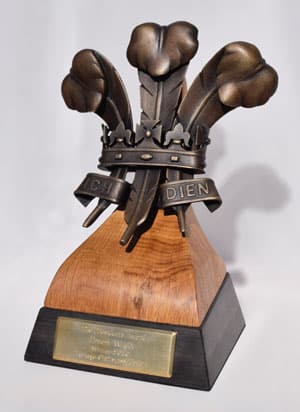 These awards were presented by HCA President HRH The Prince of Wales on 10 September 2021 at a special presentation at Dumfries House, to 2021 President’s Award for Endangered Crafts winner Rebecca Struthers and 2020 winner Ernest Wright Scissors.
These awards were presented by HCA President HRH The Prince of Wales on 10 September 2021 at a special presentation at Dumfries House, to 2021 President’s Award for Endangered Crafts winner Rebecca Struthers and 2020 winner Ernest Wright Scissors.
The awards were generously commissioned and sponsored by HCA Vice President Richard Hefford Hobbs and approved by HRH The Prince of Wales. Sculptor Sean Hedges Quinn was commissioned to design and make the exemplar/mould from which the award was cast in bronze. Each part of the award was cast separately and then put together, in such a way that the award can be viewed from all angles, even the back.
The base supporting the feathers is made of oak from the Sandringham estate beautifully crafted by Ipswich woodworker Brendan Worsley, and stone from Balmoral. Hand engraver Ruth Anthony was commissioned to hand-engrave the plaques, working at some speed for the 2021 award as we knew the winner only in the last few weeks.
The workmanship is stunning and it has all been done using skilled heritage craftspeople.
Robin Wood talks to Endangered Crafts Manager Mary Lewis about knitting her first Gansey, an endangered craft on the Red List of Endangered Crafts.
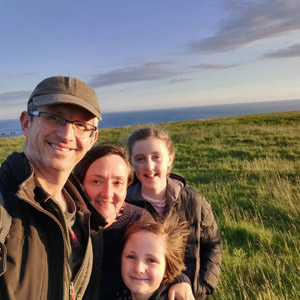
Mary and family
What does a normal day with the Heritage Crafts Association look like? If there is such a thing.
I start early with coffee. I spend a lot of time at the computer, especially during Covid, but I do also spend a lot of time talking to craftspeople. This mostly happens by Zoom at the moment and I can’t wait until I can start getting out again and meeting people in their workshops. This is a significant perk of the job, although I have to be wary of the occupational hazard that is wanting to buy all of the beautiful objects that I see being made! In normal times I would be on the train, meeting interesting and inspiring people, giving talks and trying my hand at various skills.
I do weave craft into my daily routine, I take knitting/thinking breaks and I have been known to stitch my way through long meetings (they can’t see my hands on Zoom). I use craft as a way to ‘de-frag’ my head; it helps me to focus and get my thoughts back into nice orderly lines. It was a revelation to me when I attended my first HCA board meeting and discovered that it was socially acceptable to knit! I had found my people.
How long have you been interested in heritage crafts and what started your interest?
I have never not been involved in heritage crafts. My dad, Gerwyn, is a maker of all things wood so I grew up playing with pole lathes and messing about in coracles. My mum, June, is also quite handy with a needle and so I was also doing patchwork, embroidery and sewing from quite a young age. She did also try to teach me to knit but I hated it and declared that I would never do it again; too slow and too frustrating. I didn’t really settle on a craft until I was in my thirties with a young child and a stressful job. I took up crochet when I was living in a yurt in Hampshire and it was the perfect craft for evenings on the sofa or by the fire. I found the rhythm and repetition very soothing and it is still my go-to craft for relaxation. The revelation was that it requires so few tools and can be on hand at all times. Crochet led me back to knitting and I now don’t go anywhere without a yarn-based project.
With hindsight, my unhappiest times have been when I haven’t had access to craft. I remember finding myself in my halls of residence in London that smelled of plastic carpets and vinyl, with no sewing machine and no bits of wood to play with, feeling really quite bereft. I now know that making things isn’t optional for me, I need it to keep my brain healthy.
Was there ever a time when you felt heritage crafts were uncool and you actually wanted to run away and do something different?
Well, there was that time when my dad turned up at school carrying a coracle…
Honestly, I don’t think being cool was ever much of a priority for me and anyway, the coolest people I knew were craftspeople and artists. My art teachers Warb and Meabh (a tapestry weaver) were my benchmark of cool and I used to hang out with them in the art department drinking black coffee and feeling like a grown up. I still visit them in the South of France.
I did well at school and so it was expected that I would take an academic route. I don’t regret this as such, but I do think that I should have done the Art and Design A-levels that I was talked out of in favour of academic subjects. Having said that, I very much value the critical thinking skills that I learned at University. I wish that I had found knitting while I was studying, I think I would have been more content.
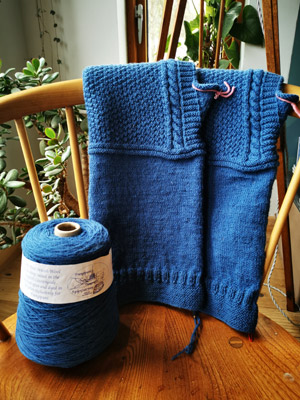
Gansey in progress
What prompted you to attempt a Gansey?
My professional answer would be that it gives me greater insight into the craftspeople I work with, but in reality it is more that I can’t pass up on a challenge! I have been involved in the Knitting The Herring project with the Scottish Fisheries Museum and, following one meeting, my colleague Daniel threw down the gauntlet with “so, are you going to make one?” I made mine for my dad, who is a sailor and has built two wooden boats in his retirement. He is not a fisherman but he has always wanted a real gansey.
Can you tell us a bit about the history of Ganseys. Where were they made? By who and for whom?
It’s complicated, and there are differences of opinion, but it is essentially a working class tradition of fishing communities around the British coastline. The more I have learned about Ganseys, the more I can see that they are telling the story of fishing communities and connections across the North Sea. This is not a tradition of a single place but of travelling and exchange. Ganseys can also be found in the Netherlands and across Northern Europe as well as within fishing communities across the UK. They tell a story of hard graft, whether you were a fisherman or a herring lassie. Knitting would have often happened in down time, after a gruelling day of gutting herring. They were knitted by men and women, but mostly by women.
Ganseys were made as the high performance work wear of their day and had a number of features that made them suitable for the job: warm and windproof, high necked, shorter sleeves so they didn’t get soggy and using construction methods that made them easily mended. They would have been grubby, heavily darned items of clothing. Many old surviving ganseys were probably ‘Sunday best’ ganseys, the others would have been worn until they were unwearable.
Patterns were handed down by word of mouth, hand and eye. As a knitter myself, I can see that they also tell a story of female skill and creativity. They are not just practical, they were made with care, love and with beauty in mind. These women must have taken huge pride in their work and used it as a means of self-expression. They probably also knitted together, which is an age old way in which women have socialised together, just as we do today in knitting groups and clubs.
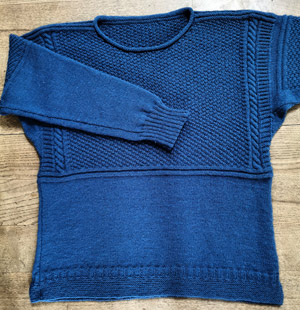
Finished Gansey
Is there truth in the stories about the patterns being for identifying drowned sailors? Why not just sew in a name tag like at school? Is this a myth made up late in the day?
I am fascinated by the stories and mythology that surround Ganseys; whether or not you believe that ganseys were knitted so that sailors could be identified if they were washed overboard, this is part of the mythology of ganseys. It is likely that these were just ‘yarns’ or tall tales, perhaps they were made up by sailors to add to the mystery. They did sometimes have initials knitted into them, so there may be some truth in it somewhere in the mists of time.
They do have locally distinctive patterns and there are variations between ganseys knitted in different communities. However, it seem obvious to me that, whilst there are patterns associated with different areas, women also would have knitted what they liked and took inspiration from others. In this sense, nothing changes.
What material are they made from?
They are made using a hardwearing ‘worsted’ spun wool which is different to ‘woollen’ spun wool. Worsted wool is smooth, hardwearing and slightly shiny compared with woollen spun wool that has more air and ‘loft’. The resulting fabric has really good stitch definition and is dense and warm.
The big question… it’s clearly a very fine yarn I imagine it took forever to knit. Did you time it? Or could you estimate?
Yes, it’s 5 ply and knitted on 2.25mm needles, which is very fine. Traditionally they are knitted on long steel pins but – confession time – I did mine on modern circular needles. I knitted mine over five months, but I probably do less than an hour a day. I reckon it took me about 150 hours in total.
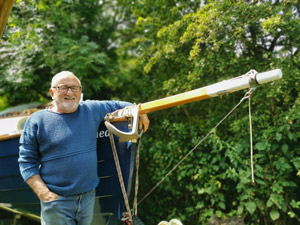
Gerwyn Lewis in his Gansey
I think I’ve heard you talking about knitting in the round as against knitting flat panels and sewing them together. Is that the way this is made? What are the advantages of one vs the other and when was each technique most popular?
Traditionally sweaters would have been made in the round in one piece, this is still common in Scandinavian knitting and has become very popular with contemporary pattern designers. Some styles are ‘steeked’ which involves knitting in the round and then cutting to insert arm holes, button bands etc. Not for the faint hearted! Until recently Gansey patterns were not written down, so knitters had to understand the mathematics and skill of being able to size and adapt patterns. I love knitting like this as I find it much intuitive than flat patterns, you can judge sizing and adjust as you go along.
I don’t know the detailed history but as I understand it, flat patterns, in which panels are knitted separately and then sewn together like a sewing pattern, was popularised when patterns started to be written down and distributed widely as paper patterns and in magazines. This enabled amateur knitters to access a much wider range of ideas and designs, but they can also quite prescriptive.
It could be argued that by writing down and recording patterns, some of the innate creativity and skill of the traditional knitter is lost. However, it is also probably the only way that gansey patterns will continue in a contemporary context as we no longer have that critical mass of knitters to pass skills on directly. As modern knitters, we tend follow patterns. I am proud of myself that I didn’t use a pattern for my gansey, instead it was more of a ‘recipe’ and I had to figure out the sizing and designs for myself by making swatches. Deb Gillanders of Propagansey is passionate about teaching without a pattern. I called her when I was thinking of making one and she said “Know your tension. Knit a swatch. Just get on with it.” She says on her website “This approach works best for jazz or folk – classically trained knitters may get nervous. On the other hand if this is what you’ve grown up with, having to follow a pattern feels like climbing rigging wearing a safety harness.”
What is the future of hand-knitting as a heritage craft?
The future is looking great, there are a huge number of knitters in the UK and many talented designers. However, it is a particular bug-bear of mine that ‘women’s crafts’ are often not give the same artisan status as crafts that were typically associated with men. They are considered the realm of the domestic rather than the artistic, and the preserve of ‘old ladies and knitting nanas’. This is changing though, and the new narrative around knitting includes extraordinary male knitters, trans knitters, black knitters, young knitters and knitting as activism, as well as women claiming and owning knitting as a way in which we define and express ourselves. Knitting is political.
Mary has been the Endangered Crafts Manager with the Heritage Crafts Association since 2018. She works on a range of tasks with the common aim of safeguarding endangered heritage crafts skills including the Red List of Endangered Crafts, the Endangered Craft Fund and other projects.


 This autumn, David Linley (the Earl of Snowdon) and I are delighted that our book, Craft Britain: Why Making Matters will be published. We began talking about this idea pre-COVID, but the pandemic and its consequences inspired us to bang the drum for making and makers across all aspects of craft from heritage to cutting edge.
This autumn, David Linley (the Earl of Snowdon) and I are delighted that our book, Craft Britain: Why Making Matters will be published. We began talking about this idea pre-COVID, but the pandemic and its consequences inspired us to bang the drum for making and makers across all aspects of craft from heritage to cutting edge.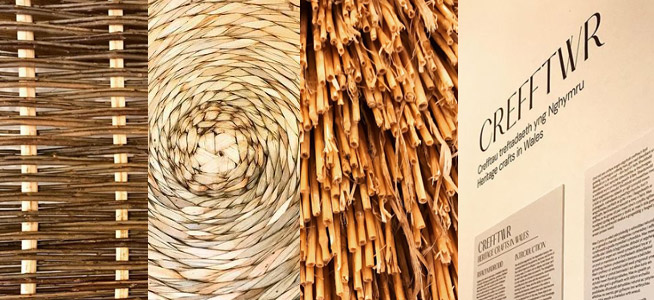

 These awards were
These awards were 




